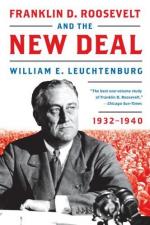
|
| Name: _________________________ | Period: ___________________ |
This test consists of 5 multiple choice questions, 5 short answer questions, and 10 short essay questions.
Multiple Choice Questions
1. As "Over the Top" concludes, Leuchtenburg reports that by the spring of 1934 there were twice as many men working as the year before in which city?
(a) Detroit.
(b) St. Louis.
(c) Des Moines.
(d) New York.
2. When discussing his time as Governor, Leuchtenburg says that Roosevelt accomplishes gains in all but which of the following areas?
(a) Conservation.
(b) Immigration reform.
(c) Industrial welfare.
(d) Unemployment relief.
3. In the spring of 1932, in which state is Roosevelt Governor?
(a) New Jersey.
(b) New York.
(c) Oregon.
(d) Pennsylvania.
4. How many days does it take Congress to pass the economy bill in March 1933?
(a) 16.
(b) 31.
(c) 9.
(d) 2.
5. After founding his political organization, in which of the following states does Huey Long successfully rally a crowd of farmers in the spring of 1935?
(a) Louisiana.
(b) Iowa.
(c) Colorado.
(d) Arkansas.
Short Answer Questions
1. On which of the following dates does the special session of Congress convene in "The Hundred Days' War"?
2. During the summer of 1933 farmers uproot their cotton crop to prevent over-saturation of the market. How much do farmers collect for plowing up 10 million acres of cotton?
3. On Roosevelt's very first night in office, he directs his Secretary of the Treasury to draft an emergency banking bill. Who is the Secretary of Treasury?
4. In "The Politics of Hard Times," which of the following individuals says that Roosevelt is "a pleasant man who, without any important qualifications for the office, would very much like to be President"?
5. Which of the following individuals had Roosevelt appointed as Governor of the Federal Reserve Board in 1934 who began pushing for a major banking bill in February of 1935?
Short Essay Questions
1. Explain how Roosevelt was finally able to collect enough delegates to make him the Democratic nominee for President in 1932.
2. Discuss the conflict between "wets" and "drys" during the 1932 campaign and the effect on the Democratic platform.
3. According to "Over the Top," why did some people consider the National Recovery Administration (NRA) a failure?
4. Describe Hoover's problem with the Bonus Army situation as discussed in "The Politics of Hard Times."
5. What were the accomplishments of the Public Works Administration from 1933-1939?
6. In "The Politics of Hard Times," why was the Republican party sure to lose the 1932 election?
7. Explain the Old Age Revolving Pensions proposal put forth by Doctor Townsend, as discussed in "Waiting for Lefty."
8. Explain the results of the Senate investigation ordered by Hoover toward the end of his term, led by Ferdinand Pecora.
9. Explain what can be considered ironic about the speeches of Roosevelt and Hoover during the 1932 Presidential campaign.
10. What happened in the 1934 Congressional elections, and why was the result surprising?
|
This section contains 1,502 words (approx. 6 pages at 300 words per page) |

|




